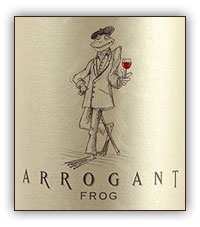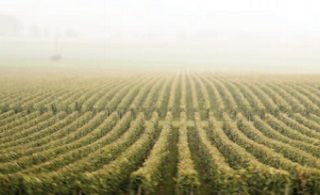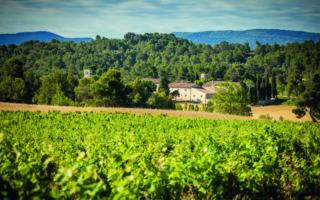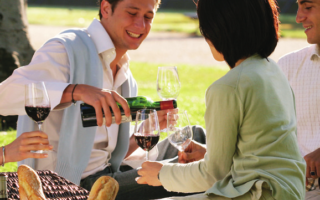Discover the Delights of Rosé Wine


Ros
It’s summer, so it doesn’t matter what wine you drink as long as it’s pink. The English rediscovered rosé in the long hot summer of 2003, but in the Languedoc it’s been quaffed for years. Wine lovers may scoff at rosé – pale and uninteresting – but when the temperatures rise, good red is hard to enjoy and even many whites don’t quite hit the spot.
But not all rosés are created equal. While most are made in the same manner as red wines, except the skins have less contact with the juice, you can make rosé simply by adding white wine to red wine. However it’s made, there is one key thing to remember when ordering a bottle in a beach restaurant. Make sure it’s as young as possible. Now you should be drinking wines from the 2005 vintage. If you have to, settle for a 2004, but on no account put up with a 2003 or anything older. The same summer that made the English crave rosé also produced a vintage that was too hot. Some rosés from that year tasted of boiled sweets; now they taste of old boiled sweets.
Perhaps because many rosé lack outstanding characteristics such as a pronounced perfume or enormous taste, it is no surprise that many a rosé is judged on its appearance alone. Some rosé drinkers insist that it should be as pale as possible, maybe because they learnt to drink the stuff on the Cote d’Azur. The best restaurants buy from Bandol, which being made mainly from Mourvèdre or Grenache grapes, is pale as a Scotsman on a beach. However, there are those who like a little more colour, light raspberry perhaps, with the same scent on the nose. Dark rosé is best avoided; it’s just red wine trying to capture the summer market.
One of the reasons why the Languedoc is a good place to drink rosé is that because of its inherent lack of complexity, the co-operatives often turn out as good a rosé as anyone else, but at half the price. People I know rave about the rosé produced by the co-op at Fontes. I prefer the wine from Cabrières, a small co-operative on a back road between Pézenas and Clermont l’Hérault. The bottle and label are among the most distinctive in the region. They won’t win any design prizes but the wine is good, a salmon pink colour made mainly from Cinsault grapes. And the price is outstanding: at 2.50€, even the most miserly host won’t get too upset when his guests start lashing it back.
One of my favourite domaines is Ollier-Taillefer. You can visit them in Fos, a pretty village just off the D13 above Gabian, between Pézenas and Bédarieux. They make some lovely wines, but the two rosés, one called Les Collines and the other Les Murettes, are both light raspberry in colour and taste.

Arrogant Frog
If you want to amuse your guests while satisfying your tastebuds, look no further than this year’s offering from Domaines Paul Mas. Their Arrogant Frog brand – created in response to the sour reaction the French were getting in America a couple of years ago – is not only amusing, but more important, tastes good and is great value for money. Jean-Claude Mas is an advocate of raspberry rosés. The Arrogant Frog rosé, around 4€ a bottle, is clean, fresh and delicious. And it comes with a screwtop, so it’s perfect for picnics.
Croix Ronde rosé
If you want to try a rosé made by mixing red and white wine, head to the little village of La Tour-sur-Orb and look for a faded sign saying Croix Ronde. Here you will find Francois and Katie Pottier. She speaks English – in fact comes originally from Macclesfield. Their rosé is a blend of Syrah and Chardonnay. Pottier says it goes well with curries; I find it goes well with most things.

Domaine Cante Perdrix
If you want a rosé that you can drink as an aperitif, but also keep drinking throughout dinner, seek out the rosé from Cante Perdrix, a small Swiss-run estate near Gabian. Madame Wyss, the delightfully named proprietor, is a great lover of Viognier and makes one of the finest you can find outside Condrieu. She has also planted some unusual red grape varieties, including Lledoner Pellut, a clone of Grenache Noir. She makes a nice spicy light red with it, but also, combined with an equal quantity of Cabernet Sauvignon, produces a dry wine she calls Rosé de Rosé. At 5€ a bottle, it’s surprisingly good value and quite delicious. And the colour’s not bad either.
Cave Coopérative de Cabrières
Cabrières
Tel : 04 67 88 91 60
Domaine Ollier-Taillefer
Fos
Tel : 04 67 90 24 59
Domaines Paul Mas
Château de Conas
Tel : 04 67 90 16 10
www.arrogantfrog.fr
Domaine de la Croix Ronde
La Tour-sur-Orb
Tel : 04 67 95 35 05
www.croixronde.com
Cante Perdrix
Gabian
Tel : 04 67 24 77 63
For more information on these domaines and others, see Rupert Wright’s Wine and Landscape of the Languedoc, illustrated by Simon Fletcher, published by Domens, 30€. Available at bookshops throughout the Languedoc, as well as on amazon.
Rupert Wright
Share to: Facebook Twitter LinkedIn Email
More in beach, languedoc, people, summer, villages, wine
By FrenchEntrée
Leave a reply
Your email address will not be published. Required fields are marked *



